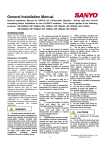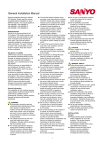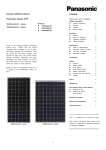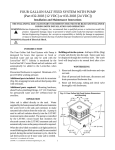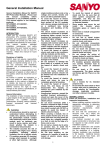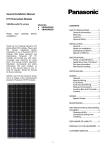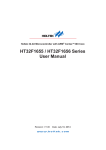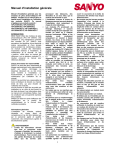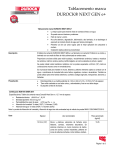Download General Installation Manual for SANYO HIT Photovoltaic Modules
Transcript
General Installation Manual © 2007 Sanyo Electric Co., Ltd. All Rights Reserved 6/15/07 General Installation Manual for SANYO • HIT Photovoltaic Modules. Please read this manual completely before use or installation of SANYO modules. This manual applies to the following models: • HIP-205BA3, HIP-190BA3, HIP-175BA3, HIP-195BA5, HIP-180BA5 HIP-200BA3, HIP-186BA3, HIP-205BA5, HIP-190BA5, HIP-195BA3, HIP-180BA3, HIP-200BA5, HIP-186BA5, • INTRODUCTION Thank you for choosing SANYO HIT® photovoltaic (PV) modules. With proper operation and maintenance, SANYO HIT PV modules will provide you with clean, • renewable solar electricity for many years. This manual contains important installation, maintenance and safety information. The word “module” as used in this manual refers to one or more PV modules. • Retain this manual for future reference. Disclaimer of Liability SANYO does not assume responsibility and expressly disclaims liability for loss, damage, or expense arising out of, or in any way connected with installation, operation, use, or maintenance by using this manual. SANYO assumes no responsibility for any infringement of patents or other rights of third parties, which may result from use of modules. No license is granted by implication or under any patent or patent rights. The information in this manual is believed to be reliable, but does not constitute an expressed and/or implied warranty. SANYO reserves the right to make changes to the product, specifications, or manual without prior notice. • • • • • • General Information The installation of solar modules requires a great degree of skill and should only be performed by qualified licensed professionals, including, without limitation, • licensed contractors and licensed electricians. • • WARNING All instructions should be read and understood before attempting to install, wire, operate, and maintain the photovoltaic module. Contact with electrically active parts of the • module such as terminals can result in burns, sparks, and lethal shock whether the module is connected or disconnected. The installer assumes the risk of all injury that might occur during installation, including, without limitation, the risk of electric shock. PV modules generate DC electrical energy when exposed to sunlight or other light sources. Although single modules produce only a low voltage and current, shocks and burns are still a potential hazard. To avoid the hazard of electric shock and injury, cover the entire front surface of the PV modules with a dense, opaque material such as a cardboard box, during installation and handling of the modules. The shock hazard increases as modules are connected in parallel, producing higher current, and as modules are connected in series, producing higher voltages. To avoid the hazard of electric shock, work only in dry conditions, with dry modules and dry tools. Do not stand or step on a module to avoid the hazard of injury and damage to the module. Do not puncture or damage the back sheet of a module, to avoid the hazard of electric shock and fire. To avoid the hazard of electric shock and injury, children and unauthorized persons should not be allowed near the installation of PV modules. To avoid the hazard of electric shock and injury, be sure to completely ground all modules. To avoid the hazard of electric shock, fire, and injury, do not disassemble the module, or remove any part installed by the manufacturer. Unauthorized persons—except the qualified licensed professional— should not open the cover of the junction box to avoid the hazard of electric shock. Provide suitable guards to prevent yourself from direct contact with 30 VDC or greater to avoid the hazard of electric shock or injury. When carrying a module, two or more people should carry it by its frame and wear non-slip gloves (to avoid injury by a slipping module, to a foot, or cuts by the edge of a frame, and so on). Do not carry a module by its wires or junction box, to avoid the hazard of electric shock, injury or damage to the module. 1 • • • • • • • • • • • Do not drop anything on the surfaces of a module, to avoid the hazard of electric shock, injury, and damage. To avoid the hazard of electric shock and fire, be sure that all other system components are compatible, and they do not subject the module to mechanical or electrical hazards. Since sparks may occur, do not install the module where flammable gases or vapors are present. Never leave a module unsupported or unsecured. Do not drop a module. Do not use or install broken modules to avoid the hazard of fire, electric shock, and injury. Do not artificially concentrate sunlight on a module to avoid the hazard of fire or damage. Do not touch the junction box terminals to avoid the hazard of electric shock and injury. Do not change the wiring of bypass diodes to avoid the hazard of electric shock and injury. CAUTIONS Use a module for its intended purpose only. Do not treat the back sheet, frame, or front surface with paint or adhesives, to avoid reducing its’ functionality, damage, inoperable conditions, and other unknown troubles. GENERAL SAFETY Follow all permission, installation and inspection requirements. • Before installing modules, contact the appropriate authorities to determine permissions, installation and inspection requirements, which should be followed. • Electrically ground modules for all systems of any voltage. If not otherwise specified, it is recommended that requirements of the latest National Electrical Code (USA) or Canadian Electric Code (Canada) or other national or international electrical standards be followed. • Be sure that the construction or structure (roof, façade, etc.) where the modules are being installed has enough strength. • For modules mounted on roofs, special construction or structures may be required to help provide proper installation support. General Installation Manual © 2007 Sanyo Electric Co., Ltd. All Rights Reserved 6/15/07 • Both roof construction and module • Please contact your SANYO installation design have an effect on Authorized Representative with the fire resistance of a building. questions regarding mounting profiles Improper installation may contribute to for modules if needed. fire hazards. Additional devices such as ground fault, fuses, and disconnects Notes on Installation may be required. • Clearance between the roof surface • Do not use modules of different and module frame is required to allow specifications in the same system. cooling air to circulate around the back of the module. This also allows any • Follow all safety precautions of other condensation or moisture to dissipate. system components used. Install modules so that air can circulate between the roof and the module. UL Listing Information To satisfy UL requirements, when installing • Leave 4 inches of clearance between the modules, be sure to: the roof and the module frame. 1) Use only stranded or solid copper single–conductor type UF cable or Operating Conditions USE cable, rated sunlight resistant, for SANYO requires that modules be operated modules and interconnect wiring that is within the following Operating Conditions: exposed to weather. 1) Terrestrial applications only—no outer 2) Observe the requirements described in space or Special Conditions (see sections labeled INSTALLTION and below). SPECIFICATIONS. 2) The ambient temperature must be 3) Grounding of the module frame is within –20°C (-4°F) to 40°C (104°F). required. When ground wires greater The temperature limits are defined as than 6mm2 (No.10 AWG) are required, the Monthly Average High or Low of the installer will need to provide the installation site. suitable terminal connectors. 3) The wind pressure load of the installation site should be less than 2 INSTALLATION 2,400N/m (50PSF). General • Please read this guide completely Special Conditions before installation or use of the Modules must not be installed nor operated modules. This section contains in areas where: electrical and mechanical 1) Salt damage is excessive. specifications needed before using 2) Hail and snow damage is excessive. 3) Sand and dust damage is excessive. your SANYO PV modules. • Modules should be firmly fixed in place 4) Air pollution, chemically active vapors, acid rain, soot, etc. are excessive. in a manner suitable to withstand all expected loads, including wind and SPECIFICATIONS snow loads. • The drilling and addition of ground Notes on Specifications holes is permitted, but should be 1) Rated electrical characteristics are within –5% to +10% of the values avoided when possible, to prevent measured at Standard Test Conditions damage to the module. Caution is (STC). Irradiance of 1000W/m, 25oC advised to avoid accidentally drilling, cell temperature, and solar spectral scratching, or penetrating the back irradiance per IEC 60904-3. sheet surface of the module. When normal conditions, a needed, it is recommended to add 2) Under photovoltaic module may experience additional ground holes to the outer conditions that produce more current aluminum lip (rail) area of the module. and/or voltage than reported at The position of additional ground holes Standard Test Conditions. Accordingly, must be at least 65mm away from the values of Isc and Voc marked on frame corners and must not penetrate UL listed modules should be multiplied the inner side of the aluminum frame. by a factor of 1.25 when determining • Appropriate material should be used voltage ratings, conductor capacities, for mounting hardware to prevent the fuse sizes, and size of controls module frame, mounting structure, and connected to the module output. USA: hardware itself from corrosion. Refer to Section 690-7 of the U.S. • Install modules where they are not National Electrical Code for an shaded by obstacles like buildings and additional multiplying factor of 1.25, trees. Especially pay attention to avoid which may be applicable. partially shading the modules by objects during the daytime. 2 3) The current output for the modules shown in the Specifications is measured at Standard Test Conditions. These conditions may not be frequently observed in actual practice. Mechanical Loading • The modules should be mounted at the four (4) quarter points by the means shown in Figures 3.1 and 3.2. • This method offers a maximum load of 2400N/m2 (50PSF, in a static state) on the module surface. WIRING General • All wiring should be done in accordance with applicable electrical codes. • Wiring methods should be in accordance with the NEC in USA or CEC in Canada. • A qualified, licensed professional should do all wiring. • Wiring should be protected to help ensure personal safety and to prevent its damage. • All modules connected in series should be of the same model number and/or type. • Do not connect modules in parallel without using a connection box. Module Wiring • The number of modules that can be wired in series is recommended at seven (7) or fewer. If connecting eight (8) modules in series, check local temperature conditions and follow the National Electric Code (690.7) to ensure compliance with maximum voltage limitations. • SANYO solar modules are not designed for “off-grid” or battery charging systems, because of their operating voltage. Therefore, it is not recommended to use them to charge batteries. • These modules contain factory installed bypass diodes. If these modules are incorrectly connected to each other, the bypass diodes, cable, or junction box may be damaged. Module Wiring • The term “array” is used to describe the assembly of several modules on a support structure with associated wiring. • Use copper wire that is sunlight resistant and is insulated to withstand the maximum possible system open circuit voltage. General Installation Manual © 2007 Sanyo Electric Co., Ltd. All Rights Reserved 6/15/07 • Check local codes for requirements. Earth Ground Wiring • Grounding should be carried out by attachment to the module or array frame, to avoid the hazards of electric shock or fire. • The array frame shall be grounded in accordance with NEC Article 250 (USA) or CEC in Canada. • Each framed module has a hole in the shorter side frame rail, to connect a grounding conductor to the module’s metal frame (see Figure 2). Module Terminations • A junction box as a terminal enclosure is equipped for electrical connections on SANYO modules. TM • Modules are equipped with MC plugs as a terminal enclosure. Use these TM MC plugs for electrical connections. it is necessary to add or change diodes As part of SANYO’s policy of continuous improvement, SANYO reserves the right to due to system specifications. change product specifications at any time MAINTENANCE without prior notice. • Some maintenance is recommended to maintain optimal output performance of For further information, please visit www.us.sanyo.com or contact your the solar modules. • If the module surface becomes dirty, it SANYO Authorized Representative. may reduce output power. • It is recommended to clean the surface of the module with water and a soft cloth or sponge, twice or more per year. • A mild non-abrasive detergent may be applied for persistent dirt. • It is also recommended to inspect the electrical and mechanical connections annually. • If you need electrical or mechanical inspection or maintenance, it is recommended to have a licensed authorized professional carry out the inspection or maintenance to avoid the hazards of electric shock or injury. Junction Box and Terminals • Modules equipped with one junction The return of any modules will not be box contain terminals for both positive accepted by SANYO unless prior written and negative polarity, and bypass authorization has been given by SANYO. diodes. • One terminal is dedicated to each polarity (with the polarity symbols engraved onto the body of the junction box) (see Figure 4). Installation (reference) This referential figure is for Conduit HIP-xxxBA3 modules. • For applications where wire conduits are used, follow the applicable codes φ8 for outdoor installation of wires in conduits. 14 • Verify that all fittings are properly 27 installed to protect wires against 27 damage and prevent moisture intrusion. Metal fitting Solar Module (4 places) DIODES Bypass Diodes • When the modules in series strings are shaded partially, it may cause reverse voltage across cells or modules, because the current from other cells in the same series is forced to flow through the shaded area. This may cause undesirable heating to occur. • The use of a diode to bypass the shaded area can minimize both heating and array current reduction. • All SANYO modules are equipped with factory installed bypass diodes. The factory-installed diodes provide proper circuit protection for the systems within the specified system voltage, so that you do not need any other additional bypass diodes. • Contact your SANYO Authorized Representative for proper diode type, if Mounting Structure Rail Metal fitting M6 Nut Spring washer Solar Module Mounting Structure Rail Flat washer Metal fitting Module M6 Bolt/setscrew Mounting Structure Rail End of Module Between Modules Figure 1. Installation 3 General Installation Manual © 2007 Sanyo Electric Co., Ltd. All Rights Reserved 6/15/07 SPECIFICATIONS Standard Models—HIP-xxxBA3 Series Electrical Specifications Model Cell Number in Series Rated Power, Watts (Pmax) Maximum Power Voltage (Vpm) Maximum Power Current (Ipm) Open Circuit Voltage (Voc) Short Circuit Current (Isc) Cell Type Maximum System Voltage (Voc) Factory Installed Bypass Diodes HIP-205BA3 96 205 56.7 3.62 68.8 3.84 HIT* 600 4 HIP-200BA3 96 200 55.8 3.59 68.7 3.83 HIT* 600 4 HIP-195BA3 96 195 55.3 3.53 68.1 3.79 HIT* 600 4 HIP-190BA3 96 190 54.8 3.47 67.5 3.75 HIT* 600 4 HIP-186BA3 96 186 54.4 3.42 67.0 3.71 HIT* 600 4 HIP-180BA3 96 180 54.0 3.33 66.4 3.65 HIT* 600 4 HIP-175BA3 96 175 52.9 3.31 65.7 3.64 HIT* 600 4 Mechanical Specifications Model HIP-205BA3 HIP-200BA3 HIP-195BA3 HIP-190BA3 HIP-186BA3 HIP-180BA3 HIP-175BA3 Length, mm (inches) 1319 (51.9) Width, mm (inches) 894 (35.2) Weight, kg (pounds) 35 (1.4) 14 (30.9) Dimensions Ground Location (1 place) Standard Models: HIP-205BA3, HIP-200BA3, HIP-195BA3, HIP-190BA3, HIP-186BA3, HIP-180BA3, HIP-175BA3 Dimensions in mm Ground (1 place) Junction Box Label Junction Box positive ( + ) negative ( - ) Label 63cm (24.8in) 78cm (30.7in) Connector (MCTM Plug) Backside The ground hole is on the inside of the module frame. Figure 2. Module Ground Position Mount Locations (4 places) Front Side Backside Note:AAmodule module should is installed on a Note: be attached onplatform a mount or support structure rail with standard setting range within the shaded range. (shaded) Section A-A’ Figure 3.1 Standard Model Dimensions 4 General Installation Manual © 2007 Sanyo Electric Co., Ltd. All Rights Reserved 6/15/07 SPECIFICATIONS Deep-Frame Models—HIP-xxxBA5 Series Electrical Specifications Model Cell Number in Series Rated Power, Watts (Pmax) Maximum Power Voltage (Vpm) Maximum Power Current (Ipm) Open Circuit Voltage (Voc) Short Circuit Current (Isc) Cell Type Maximum System Voltage (Voc) Factory Installed Bypass Diodes Mechanical Specifications Model Length, mm (inches) Width, mm (inches) HIP-205BA5 96 205 56.7 3.62 68.8 3.84 HIT* 600 4 HIP-200BA5 96 200 55.8 3.59 68.7 3.83 HIT* 600 4 HIP-195BA5 96 195 55.3 3.53 68.1 3.79 HIT* 600 4 HIP-190BA5 96 190 54.8 3.47 67.5 3.75 HIT* 600 4 HIP-186BA5 96 186 54.4 3.42 67.0 3.71 HIT* 600 4 HIP-180BA5 96 180 54 3.33 66.4 3.65 HIT* 600 4 HIP-205BA5 HIP-200BA5 HIP-195BA5 HIP-190BA5 1319 (51.9) 894 (35.2) 60 (2.4) HIP-186BA5 HIP-180BA5 Frame Depth, mm (inches) Weight, kg (pounds) 14 (30.9) Dimensions For More Information, Models (deep-frame): HIP-205BA5, HIP-200BA5, HIP-195BA5, Please Contact SANYO HIP-190BA5, HIP-186BA5, HIP-180BA5 Authorized Representatives Ground (1 place) at:Dimensions in mm www.sanyo.com/industrial/sol ar/representatives.cfm Junction Box Label negative (-) positive ( + ) 78cm (30.7in) 63cm (24.8in) Connector (MCTM Plug) Cable Connector MCTM Plug Mount Locations Front Backside Side negative ( - ) Note: A module should be installed on a support structure rail in accordance with the following: > Use four (4) symmetrical mounting points within set range A. positive ( + ) Figure 4. Configuration of Junction Box Section A-A’ Figure 3.2 Deep-Frame Model Dimensions 5





